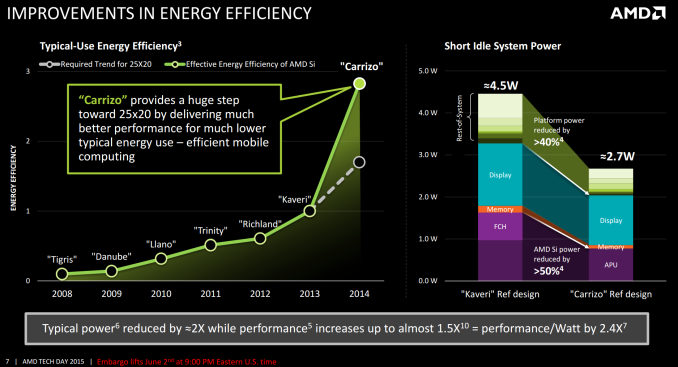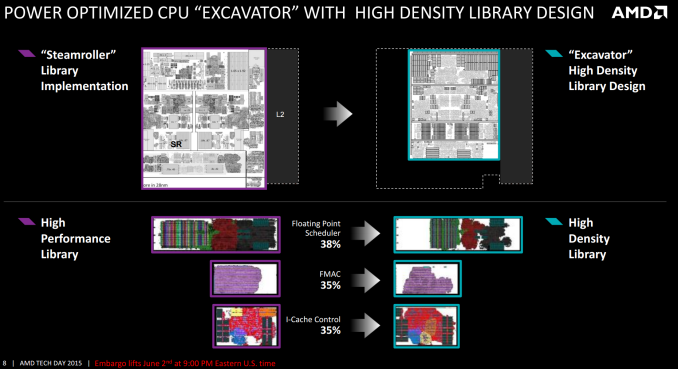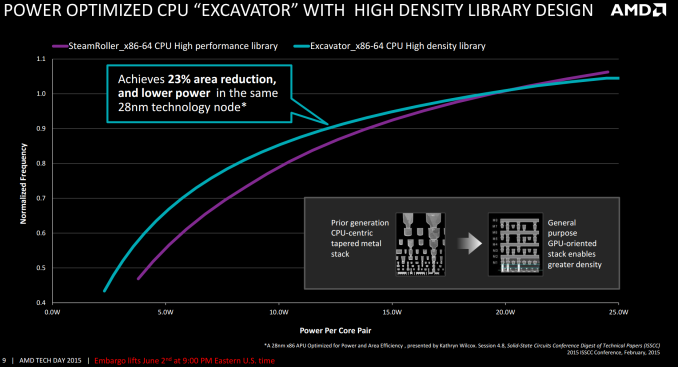AMD Launches Carrizo: The Laptop Leap of Efficiency and Architecture Updates
by Ian Cutress on June 2, 2015 9:00 PM ESTEfficiency and Die Area Savings
AMD’s take home message in all of this is efficiency. We a being quoted a performance per watt increase of 2.4x, coming from typical power draw savings of 2x and performance increase of almost 1.5x for 23% less die area, all in one go.
Ultimately this all helps AMD’s plan to be 25x more efficient with their APUs by 2020, and the cumulative bar chart on the right is how mobile improvements from all sides are being realized. Migrating the southbridge on die severely reduces its idle power consumption to almost zero and can help efficiencies elsewhere in the system. The APU general use and memory controllers are the next targets, but the common constant here is the display. Using a low power display might give battery life in exchange for quality, and there is only so much power you can save at the SoC level. In time, the display will be the main focus of power saving for these devices.
A big part of the reduction in die area comes from the set of high density libraries being used by AMD. Above were three examples provided where >33% gains were made in silicon area. Typically using a high density library design is a double edged sword – it reduces die area and potentially leaves more area for other things, but the caveat is that it may be more prone to defects in construction, require additional latency or have a different frequency/voltage profile. AMD assures us that these changes are at least like-for-like but most of them contain other improvements as well.
It’s worth noting here that AMD has described the high density library project internally as the equivalent of a moonshot, essentially the developers were part of a ‘skunkworks’ division attempting to make drastic changes in order to improve performance. The high density library is one such successful project from that.
With the new libraries, comparing Excavator to Steamroller shows the effect moving designs has. The power/frequency curve below 20W per module shifts to higher frequency/lower power, whereas losses are observed above 20W. However for 15W per module, this means either a 10%+ power reduction at the same frequency or a 5% increase in frequency for the same power. Should AMD release dual thread / single core APUs in the 7.5W region, this is where most of the gains are (as noted in the comments, the dual module designs are at 7.5W per module, meaning that what we should see in devices is already in the peak value for gains and benefits such as 25% frequency or 33% power). As also seen in the insert, the silicon stack has been adjusted to a more general purpose orientation. I could comment that this makes the CPU and GPU work better together, but I have no way of verifying this. AMD states the change in the silicon stack makes production slightly easier but also helps with achieving the higher density Excavator exhibits.













137 Comments
View All Comments
FlushedBubblyJock - Tuesday, June 9, 2015 - link
amazing how a critically correct comment turns into an angry ranting conspiracy from youBillyONeal - Wednesday, June 3, 2015 - link
This is a preview piece. They don't have empirical data because the hardware isn't in actual devices yet. Look at any of AT's IDF coverage and you'll see basically the exact same thing.Refuge - Wednesday, June 3, 2015 - link
nothing has been released yet. but it was announced. This is a news site, you think they are just going to ignore AMD's product announcement? That would be considered "Not doing their job"They go through the claims, explain them, try to see if they are plausible with what little information they have. I like these articles, it gives me something to digest while I wait for a in depth review, and when I go to read said review I know exactly what information I'm most interested in.
KaarlisK - Wednesday, June 3, 2015 - link
About adaptive clocking.Power is not saved by reducing frequency by 5% for 1% of the time.
Power is saved by reducing the voltage margin (increasing frequency at the same voltage) _all_ the time.
Also, when the voltage instability occurs, only frequency is reduced. The requested voltage, IMHO, does not change.
ingwe - Wednesday, June 3, 2015 - link
Interesting. That makes more sense for sure.name99 - Monday, June 8, 2015 - link
It seems like a variant of this should be widely applicable (especially if AMD have patents on exactly what they do). What I have in mind is that when you detect droop rather than dynamically change the frequency (which is hard and requires at least some cycles) you simply freeze the entire chip's clock at the central distribution point --- for one cycle you just hold everything at zero rather than transitioning to one and back. This will give the capacitors time to recover from the droop (and obviously the principle can be extended to freeze the clock for two cycles or even more if that's how long it takes for the capacitors to recover).This seems like it should allow you to run pretty damn close to the minimum necessary voltage --- basically all you now need is enough margin to ensure that you don't overdraw within a worst case single-cycle. But you don't need to provision for 3+ worst-case cycles, and you don't need the alternative of fancy check-point and recovery mechanisms.
KaarlisK - Wednesday, June 3, 2015 - link
About that power plane."In yet more effort to suction power out of the system, the GPU will have its own dedicated voltage plane as part of the system, rather than a separate voltage island requiring its own power delivery mechanism as before"
As I understand it, "before" = same power plane/island as other parts of the SoC.
Gadgety - Wednesday, June 3, 2015 - link
Great read and analysis given the fact that actual units are not available for testing.As a consumer looking for use of Carrizo beyond laptops, provided AMD releases it for consumers, it could be a nice living room HTPC/light gaming unit.
Laxaa - Wednesday, June 3, 2015 - link
I would buy a Dell XPS13-esque machine with this(i.e. high quality materials, good design and a high res screen)Will Robinson - Wednesday, June 3, 2015 - link
According to ShintelDK and Chizow...the above article results are from an Intel chip and AT have been paid to lie and say its Carrizo because their lives would have no meaning if it is a good product from AMD.